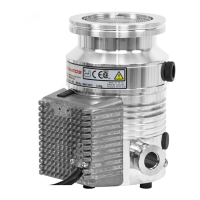B722-40-880 Issue F
Page 22 © Edwards Limited 2013. All rights reserved.
Edwards and the Edwards logo are trademarks of Edwards Limited.
Installation
3.3.2 Mechanical fixing
There are two ways in which the DX pumps can be securely fixed. The ideal fixing for a DX pump is via its inlet flange
to a rigid, firmly fixed vacuum system - refer to Section 3.3.3. If this is not possible because of the nature of the
vacuum system, then the base of the pump must be fixed to a firm support. Refer to Section 3.3.4 for instructions
on base mounting the pump.
3.3.3 Inlet connection and orientation
The pump can be securely fixed to the vacuum system via the inlet flange. The pump can be mounted in any attitude
from the vertical and upright through to horizontal (2°). If the pump is mounted horizontally, and a rotary vane
pump is used to back the DX pump, then the backing port must point vertically downwards (20°) to reduce the risk
of contamination from the backing pump oil.
Make sure that the pump inlet and all components fitted to the pump inlet are clean and dust-free. If the pump inlet
is not kept clean, the pump-down time may be increased.
The inlet connections for the EXT75DX are CF flange, ISO flanges and the NW flange. The inlet connections for the
EXT255DX are CF flange and the ISO flange:
If the pump has a CF flange, use the copper compression gasket supplied with the pump and use a full
complement of bolts to connect the inlet flange of the pump to the vacuum system.
If the pump has an ISO flange, use the Edwards trapped O-ring supplied with the pump and use a minimum of
four claw clamps (each torqued to 10 Nm) to connect the inlet flange of the pump to the vacuum system.
Alternatively, use a rotatable collar and the trapped O-ring supplied with the pump to connect the inlet
flange of the pump to the vacuum system; use a full complement of bolts with the rotatable collar.
If the pump has an NW flange, use the centring ring supplied with the pump and a metal NW clamp to
connect the inlet flange of the pump to the vacuum system. In this case, fix the base of the pump to a firm
support as described in Section 3.3.4.
All inlet flange bolts must be re-tightened once the system is under vacuum. Ensure that no torques or other forces
are transmitted to the pump from the vacuum system or the associated pipelines. If necessary, fit an inlet vibration
isolator between the pump inlet and the vacuum system (refer to Section 7.4). In this case, fix the base of the pump
to a firm support as described in Section 3.3.4.
3.3.4 Base mounting
The base of the DX pump can be fixed to a firm support using the tapped fixing holes. Refer to Figure 1 and 2 for
fixing hole details.
Note: For EXT75DX only, the four screw-in rubber feet must be removed from the four tapped fixing holes before
the pump can be base mounted.
Do not operate the pump until it is securely fixed. If the pump seizes, the stored energy of the
rotor can cause rapid movement of the pump, which may cause further damage and injury to
people.

